Episode 36: Wreck of the Medusa
It was Dupont, the army officer, who first saw the sail on the horizon. Or was it real at all? Dupont, like the other 14 men on the makeshift raft, was suffering from malnutrition and heatstroke, sunburned so badly the skin had blistered, “blinded by the screaming light, emaciated [and] hallucinating.”1 Though the survivors waved handkerchiefs, the distant sail seemed to come no closer, until suddenly it was gone.
“From the delirium of joy, we fell into profound despondency and grief,” wrote two of the men on the raft. There were just 15 of them left after 13 days on the open ocean, the only survivors from 146 desperate men and one woman who had originally clambered onto the raft. “We envied the fate of those whom we had seen perish at our side,” the survivors wrote, and they resolved to lie down and “await death with resignation.”2
But the sail had not been a delirious illusion. It was real. It belonged to a French brig named the Argus. And the Argus, blessed by fortunate winds, circled back again to locate and rescue the survivors.
It was July 17, 1816. The men were 32 nautical miles off the cost of western Africa, and 90 miles from the sandbank where their warship had run aground.3 They were survivors of one of the most infamous shipwrecks in world history, a catastrophe as closely tied to the domestic dramas of Restoration France as it was to the harsh realities of France’s colonial empire.
This is The Siècle, Episode 36: Wreck of the Medusa.
Welcome back, everyone. Today we’ll be taking a long-overdue look at France’s colonies, using the dramatic 1816 story of the Medusa shipwreck as our entry point. This story will tie together famous incidents I’ve covered in prior episodes and lay the groundwork for the exciting events that await our main narrative in 1830.
As a reminder, The Siècle is a proud member of the Evergreen Podcasts network. You can find more information about every episode, including full transcripts, citations and images, online at thesiecle.com. You can also support the show on Patreon for as little as $1 per month; all patrons receive an ad-free feed of the show. Find out more at thesiecle.com/support.
I’ll also throw in a warning here: this episode is going to discuss a series of unpleasant topics, including murder, starvation, cannibalism, slavery and colonization. Listener discretion is advised.
Alright, let’s get into it.
Colonial Senegal in 1816
Months before the grisly tragedy of the raft, the warship Méduse, or “Medusa,” had been ordered to lead a mission of national importance to France’s newly re-established Bourbon monarchy: to take back control of France’s African colony of Senegal.
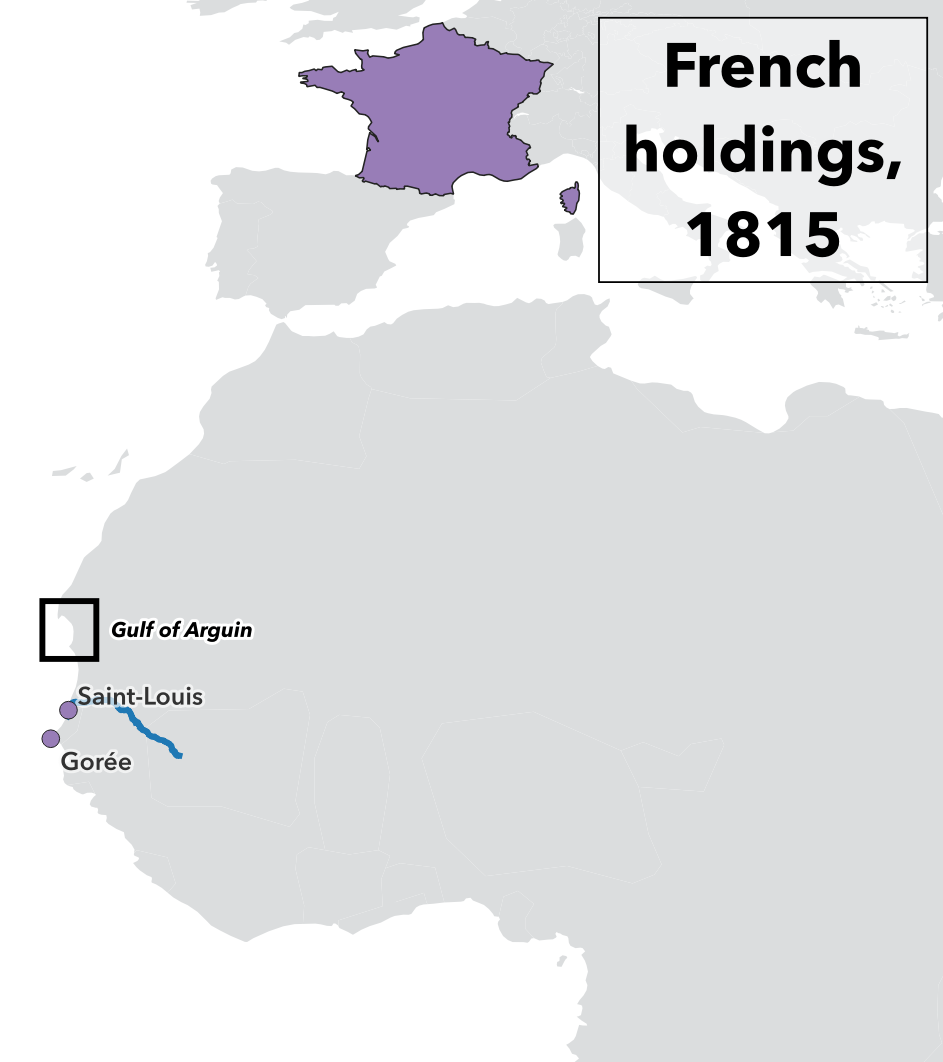 But that phrase, “colony of Senegal,” may mislead some of you. In the 2020s, the modern country of Senegal occupies more than 75,000 square miles of West Africa. In the 1920s, the French colony of Senegal occupied much the same area.4 But in the early 1820s, we shouldn’t even be talking about “area” — France’s colonial possessions in West Africa were little more than a handful of coastal trading ports. Of these, the most important were Gorée, an island off the coast of what is today the Senegalese capital of Dakar, and Saint-Louis, at the mouth of the Senegal River.5 You can visit thesiecle.com/episode36 to see some maps.
But that phrase, “colony of Senegal,” may mislead some of you. In the 2020s, the modern country of Senegal occupies more than 75,000 square miles of West Africa. In the 1920s, the French colony of Senegal occupied much the same area.4 But in the early 1820s, we shouldn’t even be talking about “area” — France’s colonial possessions in West Africa were little more than a handful of coastal trading ports. Of these, the most important were Gorée, an island off the coast of what is today the Senegalese capital of Dakar, and Saint-Louis, at the mouth of the Senegal River.5 You can visit thesiecle.com/episode36 to see some maps.
Right: Map of French holdings in 1815, with the location of the Gulf of Arguin marked. Map by David H. Montgomery, using geographic data from André Ourednik.
The rest of the territory that makes up modern-day Senegal was controlled by local rulers, including the Waalo, Futa Tooro and Kajoor. To the north of the Senegal River, the Moorish emirates of Trarza and Brakna were major regional powers.6
These European coastal trading posts had existed for centuries, clinging to a precarious existence along the Atlantic coast because of the massive profits to be made selling two hotly desired commodities.
Gum and slaves
One, “gum arabic,” is the hardened sap of trees that grow only in the Sahel, the region of Africa south of the Sahara. Gum arabic was an indispensable ingredient for textile dyeing, for making silk and paint, for printing and food processing, and more. It is, in fact, still a valuable industrial product today. Back in the early 19th Century, one ton of gum arabic could fetch as much as 180 pounds in London, equivalent to the entire annual income of a clergyman like Jane Austen’s father. Gum arabic was an extremely valuable product that could only be found on the Atlantic coast of northwest Africa, and the French efforts to monopolize its trade in the 18th Century led to the so-called “Gum Wars” with British and Dutch interests.7

Above: Pieces and powder of raw gum arabic, by Simon A. Eugster from base images by Zerene Stacker. Used under a Creative Commons Attribution-Share Alike 3.0 Unported license, via Wikimedia Commons
But the other subject of commerce in Saint-Louis and Gorée in the 18th Century was enslaved people. The full tragic history of the Atlantic slave trade is beyond the scope of this podcast, but it played a crucial role in shaping the broader Senegal region. Scholars estimate somewhere between 180,000 and 500,000 enslaved people were shipped across the Atlantic from this region of Africa during the 18th Century, from both French and British ports. Unknown thousands of other slaves were shipped overland to North Africa.8
The high prices paid for captive humans at ports like Saint-Louis and Gorée fueled raids and wars across the region, causing untold death and misery. Some borderland areas became entirely depopulated. Less-hard hit areas were also devastated by ceaseless violence: whether captured, resisting capture or trying to capture others, able-bodied men were pulled away from food production. One French observer noted in 1758 that “kings in this country are bandits living only from pillage,” and that “as such, they destroy absolutely every possibility of their nation ever being motivated to work their lands.” The Senegalese historian Boubacar Barry notes that this verdict “holds true” for the entire region “in the era of the slave traders.”9
All this misery did make some people very rich — not just Europeans but also some local leaders and mixed-race Euro-African traders, who established themselves as wealthy and powerful middle-men in the slave ports. I say “middle-men” but in many cases these Euro-African traders were middle-women, so-called “signares.”10
Enslaved people seem to have been the more commercially important product sold in Senegal for most of the 18th Century. The slave trade began to decline starting around the end of the 1700s, spurred by economics but also political decisions. Revolutionary France banned slavery and the slave trade in 1794, though Napoleon would restore it in 1802. Britain abolished the slave trade — but not slavery — in 1807, and the United States banned the import of foreign slaves starting in 1808. The British abolition of the slave trade had particular impact on Saint-Louis and Gorée, since Britain had seized both ports from the French during the Revolutionary and Napoleonic Wars. The French colonists there, who had profited so much from trading in human beings, were now under a regime where that was illegal.11
Abolitionism
All this came to a head in 1814, when Napoleon abdicated and King Louis XVIII was restored to power. The powers of Europe met in Paris and signed a general peace treaty. Besides moving borders around in Europe, the 1814 Treaty of Paris dealt with two issues relevant here: France’s overseas colonies, and the slave trade.
In 1814, Britain was feeling generous, and agreed to return to France most of the French colonies that Britain had seized over the past two decades. A few French colonies were given to Britain, including Mauritius in the Indian Ocean, and Saint Lucia and Tobago in the Caribbean. France got the rest back, including Senegal.12
But generous wasn’t the only thing the British were feeling. Abolitionist sentiment also ran strong there. The Duke of Wellington wrote to his brother in amazement at the “degree of frenzy existing here about the slave trade,” saying that the British public seemed willing to “go to war to put an end to that abominable traffic.”13 Even Britain’s slave-owning planters were now behind abolishing the slave trade, which they had fought so hard before 1807. If they couldn’t ship captive humans across the Atlantic, British slave-owners reasoned, then certainly no one else should be allowed to either.14 With this vigorous and near-unanimous public sentiment, British diplomats made abolishing the slave trade a priority when they sat down to negotiate a peace with France.
The French negotiators were quite cool to this abolitionist pressure. Trading in enslaved people was extremely profitable for both French colonists and for French trading ports such as Nantes and Bordeaux. Plus many Frenchmen felt the whole thing was a trick — British ships had hauled more enslaved people across the Atlantic in the past 50 years than everyone else put together; Britain’s Caribbean plantations were worked by thousands of slaves to great profit; now Britain suddenly wanted to shut down the slave trade that had made them so much money? France was in a weak bargaining position in 1814, and was forced to agree to ban the slave trade — but Louis’s chief negotiator Talleyrand won a five-year delay. This concession proved unpopular in Britain, and the British offered France the Caribbean island of Trinidad as compensation if France would agree to end the slave trade early. But Louis’s government had no interest in such a deal, and prepared to take full advantage of her five years of legal slaving.15
That, at least, was the plan. But then the next year Napoleon escaped from Elba and retook power. One of Napoleon’s new decrees was to immediately ban the slave trade. Coming from the man who had once re-legalized slavery, this was likely a cynical attempt to appeal to British public opinion. If so, it didn’t really work. But while Napoleon’s revived Empire went goodbye after Waterloo, his ban on the slave trade stuck around. Especially with Britain’s leverage after restoring Louis XVIII to power again, the king found it too awkward to bring the slave trade back again in 1815.16
So here we are back in 1816, with the warship Medusa and a small fleet being fitted out to formally take back control of Saint-Louis from the British. When the French governor Julien-Désiré Schmaltz arrived, his formal orders would include abolishing slavery and turning the freedmen into wage laborers.17 We’ll see what Schmaltz actually does in a little bit, because getting Schmaltz to Saint-Louis was another man’s responsibility. And Captain Hugues Duroy de Chaumareys would prove to be perhaps the worst choice imaginable for such a job.
Ill-fated voyage
There is a joke from the Restoration, in which the king’s council hears a petition from an émigré who had been a naval cadet at the time of the French Revolution. The émigré asks to be restored to active duty — and for a promotion to the rank of rear admiral, “because that would have been his rank if he had been allowed to continue his career without interruption.” In response, the council instructs the naval minister to “admit the logic of his reasoning, but add that he overlooked one essential fact: that he was killed in the Battle of Trafalgar.”18
Hugues Duroy de Chaumareys is in many ways a human personification of this joke, with one key difference: Chaumareys got his promotion.
A minor aristocrat, Chaumareys had started a promising naval career before the French Revolution. He had fought at sea in the American War of Independence, distinguishing himself for bravery under fire. He was swiftly promoted up the ranks to a transport captain, and seemed likely to rise further. But in December 1790, Chaumareys did what so many other aristocratic officers did as the Revolution accelerated: he fled overseas and became an émigré.
Chaumareys would stay overseas until 1804, when he took Napoleon’s amnesty offer and returned to wait out the Empire in a quiet job as a Customs officer. Then came the Restoration, and like so many other aristocratic émigrés, Chaumareys asked for a job. Unlike so many émigrés who Louis disappointed, Chaumareys got his job: captaining the Medusa and commanding the expedition to Saint-Louis — despite not having commanded a ship in more than two decades.19
And this was a job where experience was crucial. The route to Senegal was treacherous. It featured strong currents and the dangerous Arguin Bank, a massive, poorly-charted sand bank miles away from the coast north of Senegal. The area was notorious for shipwrecks. The French naval ministry, in giving Chaumareys his appointment, urged him to arrive at port long before his posting began, in order to learn from sailors in his expedition who had more experience in the area. They also sent him a recent book from the French naval cartography office, which warned that “it would be dangerous to trust” the maps of the region.20
It may not surprise you to learn that Hugues Duroy de Chaumareys followed none of this excellent advice.
To be sure, the captain did meet with the other officers on the expedition, all of whom were experienced sailors. Unfortunately, they had gotten this experience fighting for the Imperial or Revolutionary navies, anathema for a proud émigré like Chaumareys. Such a difference in background and beliefs would have been a challenge for even a skilled and flexible commander, and Chaumareys was neither of those. He immediately clashed with both the other captains on the expedition and with the junior officers on the Medusa itself. For example, when the ship approached the Atlantic island of Madeira — 12 hours later than Chaumareys had predicted — the captain ignored the advice of his officers that the ship was drifting too close to shore. It wasn’t until what one historian dubs “a lively exchange of views” with two of his lieutenants that Chaumareys conceded and steered the ship safely back out into open water.21
The situation was compounded because while the inexperienced Chaumareys wasn’t listening to his own officers, he was increasingly listening to nautical advice from one of his passengers. Antoine Richefort was a gentleman and self-proclaimed scholar, who was intended to serve the Saint-Louis colony in a scientific capacity. At odds with his Bonapartist officers but lacking expertise himself, Chaumareys increasingly started taking Richefort’s advice on navigation — advice the self-confident Richefort was all too happy to give.22
And Richefort’s advice was not harmless boasting. Extremely consequentially, Richefort steered Chaumareys along a route close to the west coast of Africa. This went against all conventional wisdom for how to sail through this area. The other captains in the expedition all steered their ships safely out to sea. The Medusa’s junior officers urged the same course, but were overruled by Chaumareys, who called Richefort “a good and able seaman” and ordered everyone to obey Richefort as the ship’s pilot. Historian Alexander McKee speculates that this risky course was simple pride on Richefort’s part: “a voyage far out from land would be uneventful and give no indication of the skill of the navigator.”23 If true, Richefort wasn’t wrong: the Medusa’s voyage would give an indication of its navigator’s skill, and it would definitely not be uneventful.
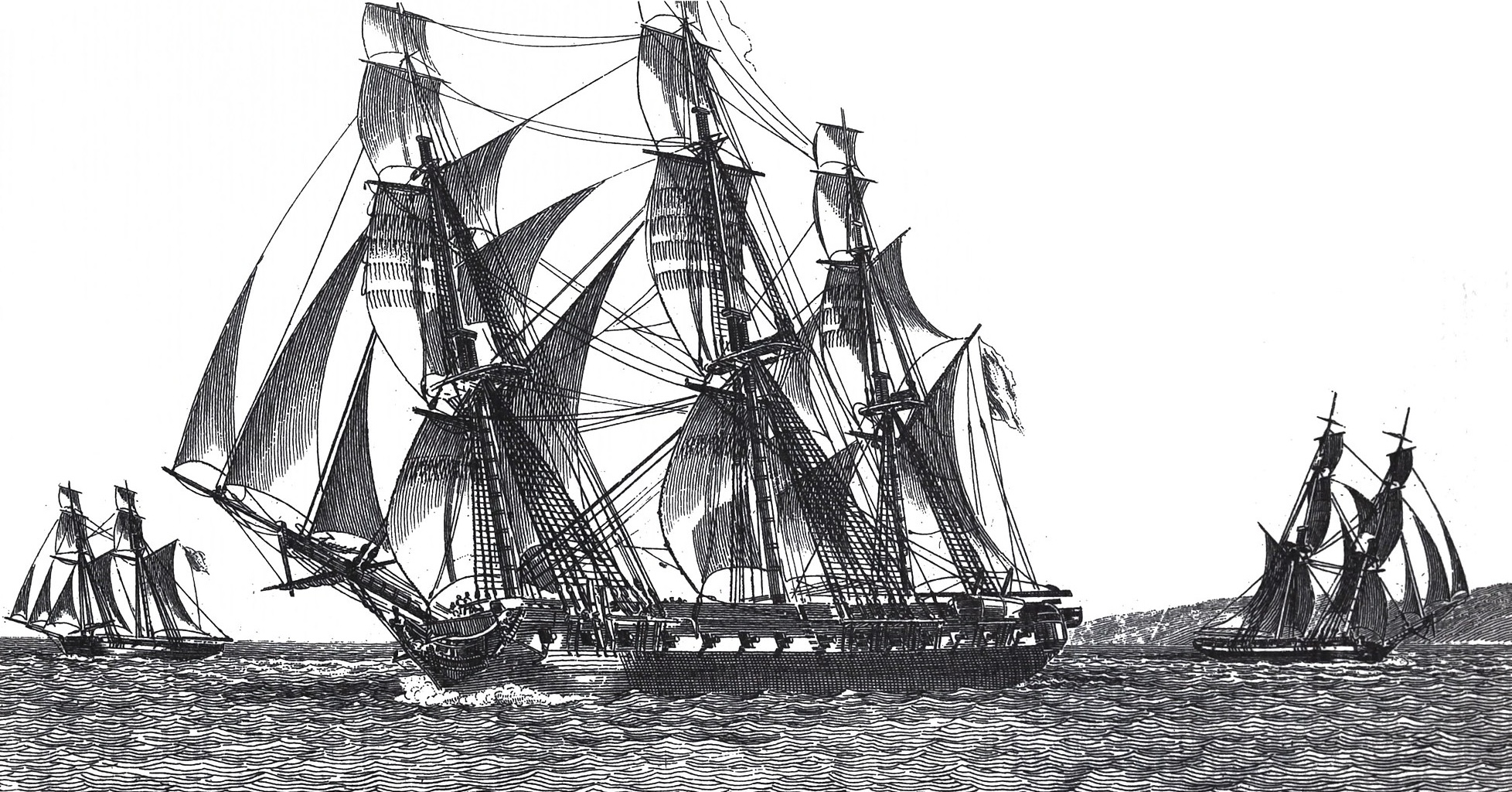
The Medusa (center) under sail, by Jean-Jérôme Baugean, c. 1817-19. Public domain via Wikimedia Commons.
Unfathomable
The tension ratcheted up by the hour. Everyone on board knew the Medusa was sailing into dangerous waters — or at least, everyone except Chaumareys and Richefort. On the morning of July 1, Chaumareys calculated the ship’s position, determined that the Medusa had passed the key landmark of Cape Bardas, and adjusted the ship’s course. At midday, the Medusa actually passed Cape Bardas, which even the landlubbers on board could identify.24
In the early morning of July 2, the Medusa lost sight of the Echo, the only other ship in the expedition that had been following the Medusa’s coast-hugging course. The Echo’s captain, François-Marie de Vénancourt, was a committed royalist and former émigré like Chaumareys, but considerably more experienced. As his ship neared the Bank of Arguin, Vénancourt ordered soundings to measure the ocean’s depth every hour. This was a by-the-book precaution, and when one sounding turned up a depth of 61 fathoms, or 366 feet, Vénancourt took it as a sign that he was getting too close to shore and steered back out to sea. Chaumareys, in contrast, despite taking a more dangerous route, took soundings much more sporadically.25
As danger grew, some of Chaumereys’s officers adopted a borderline mutinous plan: they tricked him into believing that a white cloud on the horizon was Cape Blanc, the peninsula that marks the beginning of the deadly Bank of Arguin. Chaumareys was easily duped and ordered the ship to steer west, out to sea, but it was all for naught: Richefort changed course back eastward again after a mere 30 miles, not nearly far enough to escape danger. As historian Jonathan Miles notes, “the cunning group had taken the trouble to dupe a captain who was no longer in command.”26
Two ensigns calculated they were headed for the shoals, and got rebuffed by Richefort. So did one of the passengers, who had sailed this route before and announced angrily that they were on a collision course with the Arguin Bank. Ordinary sailors cheered when suddenly fishing lines hung over the side of the ship began catching cod — a sign the ship had reached shallower waters where fish were abundant. The water changed color and seaweed became more abundant. Chaumareys and Richefort refused to change course. “Never mind, we are in 80 fathoms!” Richefort replied. Eighty fathoms, or 480 feet, was certainly deep enough for the Medusa, as Richefort insisted. The warning sign he blithely ignored was that the prior sounding had been for 100 fathoms.27
From noon to 3 p.m. on July 2, the Medusa sailed further and further in to danger. A “kind of stupor” pervaded everyone on the deck, a “resigned” “melancholy.” Then a cry of alarm: looking over the edge, everyone could see specks of sand floating in the water. A sounding: 18 fathoms. At this, even Chaumareys was stirred to action and ordered the ship steered out to sea. But a sailing ship is a cumbersome thing. Another sounding: 6 fathoms. That meant the seafloor was as little as 15 feet below the Medusa’s keel.28
After two minutes, as the crew took in sail and tried to overcome the wind to steer back out to sea, the ship shuddered — the keel had scraped bottom. A momentary bump. The ship kept moving, then shuddered again. Then a third bump, more violent. The Medusa shook and listed over to one side, and moved no more.29
The outcome everyone except Chaumareys and Richefort foresaw had come true: shortly after 3:15 p.m. on July 2, 1816, the Medusa had run aground on the Bank of Arguin.30
Evacuation
This was not necessarily a fatal disaster. The ship was not wrecked, merely stuck. It was possible that the changing tides might float her free, or that the crew could pull off maneuvers to accomplish the same end.31
Efforts were undertaken. Sailors were ordered to man the pumps and remove bilgewater from the ship’s interior, which might lighten the load. Anchors were rowed away from the ship and dropped into the ocean, in the hopes that they could provide leverage to haul the Medusa free. Determined and aggressive leadership probably could have extricated the Medusa from its predicament. But the Medusa didn’t have determined and aggressive leadership. It had Chaumareys. The captain refused to allow the most drastic but effective remedy: throwing the ship’s heavy cannons overboard. Later experts conclude that probably would have freed the ship, but it would have also been a final, irrevocable move, impossible to paper over. The cannons stayed put. So did the ship.32
It’s at this moment that Governor Schmaltz took control from the hapless Chaumareys and disgraced Richefort — who had been nearly murdered on the spot by angry passengers.33 Schmaltz convened a council of leading men on the ship, where discussion quickly turned to abandoning the Medusa.34
A warship like the Medusa had six smaller boats on board. This was far too few to carry everyone on board to safety, but it did give them options. One proposal was to ferry everyone to shore in a series of trips, then march overland to Saint-Louis. This would have been dangerous, both from lack of water crossing the hot desert, and from the possibility of attacks by local Moorish nomads. Another proposal was to send a few of the boats to Saint-Louis to fetch help while everyone else remained on board.35
 But the plan the council adopted was the one proposed by Governor Schmaltz: build a large raft, capable of carrying the ship’s supplies and surplus passengers. Then everyone could sail together to Saint-Louis.36
But the plan the council adopted was the one proposed by Governor Schmaltz: build a large raft, capable of carrying the ship’s supplies and surplus passengers. Then everyone could sail together to Saint-Louis.36
They really should have gone with Option A or B.
Right: Plan of the Raft of the Medusa, by Alexandre Corréard, 1818. Public domain via Wikimedia Commons.
Lacking this foresight, construction began at once on the raft. Masts and yard-arms were lashed together, and planks nailed across them. A makeshift prow was built, barrels placed in the corners, and a small raised deck constructed. Overall the structure was 67 feet long by 24 feet wide, or 20 meters by 7. It was hurried work and had obvious flaws. When the evacuation plan was drawn up, those in command made sure to assign themselves to more seaworthy vessels.37 You can see a plan of the raft online at thesiecle.com/episode36.
For all the carefully drawn up plans, the actual evacuation was a chaotic mess. Order had already broken down after the crash, with sailors breaking into the ship’s alcohol stores and plundering passengers’s baggage. Provisions had been set aside to be loaded onto the boats, but ended up being abandoned or flung heedlessly overboard. Rather than wait for their turn on the ship’s ladder, men clambered down ropes or just jumped. Officers who had been assigned to one vessel ended up on a different one. Passengers tried to scramble onto any boat that would take them.38
Those unlucky enough to end up on the raft got bad signs from the start. By the time 40 men had climbed on, it had sunk 2 feet. By the time the raft put to sea, it would have 147 souls on board, many under water up to their waists.39
Governor Schmaltz and his family were on a 14-oar barge, along with three trunks of luggage and a host of provisions. The ship could have comfortably held 50 passengers, but only had 38 souls on board when it cut loose. Requests from other sailors or passengers to be let on board were rebuffed.40
Chaumareys himself was on a slightly smaller barge with 27 others. His presence on this boat was extremely controversial. Being a ship’s captain has a few very hard and fast rules, and one of them is that a captain is not supposed to abandon his ship. Or, at the very least, a captain should be the very last person off the ship. When Chaumareys climbed onto his barge, there were more than 60 people still on board the Medusa.41
Welcome to Saint-Louis
We’ll come back to the poor passengers of the Medusa in a moment. Instead, we’ll follow the luckiest souls: the 66 people on the captain’s boat and the governor’s boat. Both boats had promised to stay behind to tow the raft and other boats to shore. Instead, after a half-hearted attempt to tow the raft, both boats abandoned the other survivors and sailed off toward Saint-Louis. Behind them, angry castaways yelled and even threatened to open fire on their abandoners.42 But no shots were fired, and after five days of “brisk” sailing, Chaumareys and Schmaltz sailed into Saint-Louis little worse for the wear.43
There they met Thomas Brereton, the British governor in charge of the colony. It was Brereton’s duty now to transfer Senegal to Schmaltz. Brereton was in no particular hurry to do so. But to his credit, he did respond swiftly to reports of the Medusa’s disaster. The British sent men and ships out to search for survivors, and indeed helped save lives. But we’ll get to those rescue efforts in a bit.44
The British finally handed Senegal back to the French in January 1817, six full months after Schmaltz arrived. The French suspected greed — the delay meant the lucrative 1816 harvest of gum arabic would end up in the hands of British merchants. The British in turn could point to the weight of circumstances: they had expected the arrival of a well-equipped French fleet with soldiers and specialists. Instead they encountered a scattered fleet, her flagship wrecked, many of her passengers dead or ill. As historian Alexander McKee notes, “if the English had wanted an excuse to delay the handing over of the colony, this was it.”45
Despite French fears, the British did eventually turn over Senegal. The same was true of the other captured French colonies that Britain had agreed to return: Guadaloupe and Martinique in the Caribbean, French Guiana in South America, some settlements around the city of Pondicherry in southeastern India, and the Indian Ocean island then called Île Bourbon and today known as Réunion.46
The transfer of Pondicherry gives a good example of how this sort of handover happened in more normal circumstances. The French dispatched a new governor, who set sail in April 1816 with two frigates. Being captained by competent officers, these ships arrived safely in India in September after months of sailing around Africa. There were some initial negotiations, which led to the transfer process beginning on October 21. On November 18, legal sovereignty was transfered. A British commissioner was appointed to settle any disputes related to the transfer, and on December 4 this commissioner certified that all territory in the capital of Pondicherry had been handed over to the French. Farther-flung territories were transferred in January 1817, and a few settlements were disputed until as late as 1819. But the new French governor was in control of his capital a little more than two months after arriving.47
Schmaltz had to wait. But then, waiting was something Schmaltz seemed good at, at least when his own skin wasn’t on the line. The governor who had been swift to abandon the Medusa’s raft was noted as being sluggish to organize relief efforts — certainly less responsive than the British were. And even after taking control in January 1817, it wasn’t until that fall that Schmaltz dispatched an expedition to survey the nearby area.48
Slave trading in Restoration France
Something else Schmaltz could definitely not be accused of acting swiftly on were his orders to end slavery in Saint-Louis. Quite to the contrary, in fact. Letters from English observers in Senegal paint a clear picture. One wrote that “the hoisting of the white [Bourbon] flag on the ramparts of Saint-Louis and Gorée was at once the signal for commencing the slave trade without any limitation.” Within a few months, another Englishman wrote, “the coast is crowded with slave ships.”49
“It must no doubt surprise you,” a third observer wrote, “that after the solemn manner in which the French Government engaged to Abolish the Trade, that it should be carried on here so openly without any interruption from the authorities.” Yet another Englishman confronted Schmaltz on the topic and came away “convinced that the only time the administration interfered with the [slave] traders was when they were denied a portion of the profits.”50
Schmaltz may have been unusually brazen, but in tolerating the officially banned slave trade he was not unique among French colonial officials during the Bourbon Restoration. British diplomats and naval officers documented dozens of examples of slave-trading by French ships. Since the French categorically refused to allow British ships to board French ships in their hunt for slavers, slave-trading vessels of all nationalities took to flying the French flag. Josephe de Villèle, the leading French politician between 1822 and 1827, had lived on the Indian Ocean colony of the Île Bourbon for a number of years, and married a colonist.51 Villèle was particularly unsympathetic to British attempts to crack down on the slave trade. But this resistance was widespread in Restoration governments. Even when the French did agree to crack down on the slave trade, enforcement was lax. In 1818 the French in Senegal set up a naval patrol route to intercept and arrest slavers, but historian Jonathan Miles implies that when the French intercepted a slave vessel, they would simply arrest the captain rather than seizing the vessel or liberating the slaves. Wily slave traders soon put two captains on each vessel, so if one got arrested the voyage could continue. The net effect, Miles notes, was mostly to make “the trade more difficult and therefore even more profitable.”52
And if the slave trade continued, it will not surprise you to learn that domestic slavery also persisted in Saint-Louis and Gorée under the Restoration. A majority of the population of Saint-Louis were enslaved, and were the city’s primary workforce. Enslaved women worked as laundresses, prepared food, cleaned, gardened, and cared for children. Male slaves worked in construction and warehouses, and served in a range of positions on trading expeditions up and down the Senegal River. For free inhabitants of Saint-Louis, whether European or the Afro-European signares, owning slaves was a mark of wealth and social status.53
Outside of Saint-Louis, Schmaltz attempted to set up cash-crop plantations on the mainland. In 1819 he signed a treaty with the kingdom of Waalo, offering military protection from the Moorish emirate of Trarza and annual payments of more than 10,000 francs to the Waalo aristocrats. In return, France got a wide swathe of farmland, where they would attempt to grow cotton, tobacco, and sugar cane. These initial efforts at plantation farming were largely failures. While Waalo aristocrats got paid handsomely, less-elite inhabitants resented the land sale and often refused to work on the plantations. In response, the French recruited what they called “indentured laborers.” This is a form of forced labor that’s often understood to be less harsh than chattel slavery, but in practice these Senegalese indentured laborers were slaves in all but name, often violently captured and sold into bondage.54
Senegal and other French colonial possessions are going to be an ever-expanding topic on The Siècle as the 19th Century advances. I’ll talk a lot more about the people of the Senegal area and France’s efforts to expand colonial control there in future episodes. For now, we’re going to move on. I need to get back to the poor unfortunate souls who didn’t hitch comfortable rides away from the wreck of the Medusa. But first, you’ll have to endure one final digression. Because if we’re talking about French colonialism in the Bourbon Restoration, we have to talk about Haiti.
Haiti
Before the French Revolution, the Caribbean colony of Saint-Domingue was France’s wealthiest and most important. There, huge numbers of enslaved Africans working in terrible conditions produced incredibly valuable sugar harvests. But an extremely complicated mix of factors led to a successful slave uprising in the 1790s. The armies of former slaves managed to establish de facto control of the colony under the freedman Toussaint Louverture. Napoleon sent an army to suppress this rebellion in 1801; this was the context in which Napoleon re-established slavery. The French expedition managed to capture Louverture but failed to overcome stiff local resistance or deadly tropical diseases and withdrew after terrible casualties.55
By 1814, when Louis XVIII retook his throne, the people of France’s former colony of Saint-Domingue had been effectively free for more than a decade under the name of “Haiti.” But France did not recognize Haiti’s independence, either under Napoleon or under Louis. To the contrary, Louis referred to Haiti’s leaders as “runaway slaves” and pledged in October 1814 that “the restoration of the colony of Saint-Domingue… is the constant object of our concerns.” He rejected Haitian proposals to pay 80 million francs — what France had received for the entire Louisiana Purchase — in return for recognition of Haitian independence.56 Planter interests were influential in royalist circles, and one contemporary claimed that “plans of reconquest… cropped up everywhere” in the early years of the Restoration, which “usually entailed some form of re-enslavement.”57
The situation changed somewhat under Louis’s successor, King Charles X. Charles opened the 1826 parliament by declaring he was “determined to finally settle the fate of Saint-Domingue” — and by that he didn’t mean invading. “The time has come,” Charles said, to give up on dreams of retaking a colony “already lost to us for more than thirty years.”58
What happened next was certainly less brutal than an attempt to re-enslave the Haitians at gunpoint. But it remains deeply controversial to this day. Charles and Villèle agreed to recognize Haitian independence — but only in return for very stiff concessions. Haiti would grant commercial privileges to French merchants, and agree to pay 150 million francs to indemnify former French plantation owners for their lost property — both physical and human. This indemnity would be financed in part by loans Haiti would take out from French banks, a debt that Haiti didn’t pay off until at least 1883 or later. That indemnity and debt remains a political issue to this day nearly two centuries later. If Haitian president Jean-Pierre Boyer had qualms, the presence of French warships in the harbor suppressed those doubts, and Boyer signed the deal.59
This indemnity proved to be a bad deal for almost every party involved. Haiti suffered most, of course — having fought for their freedom, the Haitians now had to pay for it, too. The young, poor country was crushed — and would continue to be crushed — by a debt burden three times the country’s GDP, while lowering tariffs on French goods throttled one of the few sources of revenue it had.60
But the intended benefits of the deal for France largely failed to materialize, either. Villèle appears to have “grossly overestimated Haiti’s ability to pay.” That meant that the former planters of Saint-Domingue who were supposed to get compensated for their losses got far less than they had been told to expect — which in turn was far less than they thought they deserved. One study found that 37 percent of ex-planters got as little as 7.5 francs in compensation, and 90 percent got less than 252 francs. Historian Mary Dewhurst Lewis has chronicled the festering sense of grievance that consumed many of these planters as their promised windfall never arrived.61
Villèle also grossly overestimated the value of war-torn Haiti to French merchants. When ships arrived to take advantage of the trading concessions France had coerced, they found the impoverished Haitians had no demand for French goods, and that Haiti produced few products valuable on the international market.62
If anyone got something from this deal, it might have been the banks and investors who funded the indemnity. After all, the banks were still getting money from the Haitian debt into the 1880s. But while the financiers successfully played hardball over the subsequent century, Haiti’s limited means cut deeply into the expected profits. Haiti defaulted on its loan after just a single payment in 1826; historian Alexia Yates describes early profits for investors as “meagre” and only as good as that because of a government bailout. Loan payments would be suspended multiple times, and renegotiated multiple times, before the debt was finally paid.63
The survivors
At long last, we come back to the survivors of the Medusa, those unlucky souls who didn’t get on a boat with the captain or governor.
In general, we have three groups: the 147 unfortunates on the raft, the 172 somewhat-less-unfortunates on the ship’s four smaller boats, and 17 men who looked at the whole boat situation and decided they’d rather take their chances staying behind on the wrecked ship.
I’ll take them in reverse order. After the disasters you’re about to hear befall the other survivors, staying on the ship was a pretty smart decision — at first. These men had ample provisions left behind by the chaotic evacuation, and sustained themselves for weeks. But help didn’t come. The initial attempts to search for survivors of the shipwreck had failed to find the Medusa. Then Schmaltz sent forth another search expedition, but seems to have chosen to dispatch only a beaten-up schooner owned by one of his friends rather than take advantage of a number of better ships that were available. This odd decision was perhaps due to all the valuable items left on board during the evacuation, which a rescue ship would have first shot at plundering. This schooner was forced to turn back to port by bad weather twice, and only on the third trip did it finally find the Medusa — 52 days after it was abandoned.64
They found only three men left alive on board, all near death. A fourth man had died hours before. A fifth man had drowned. The other 12 had given up hope 10 days prior, built a raft of their own, and sailed for shore. Their raft was later found, but no trace was ever reported of the 12 men. The Medusa herself was slumped on her side and well on its way to falling apart. The rescue ship returned to Saint-Louis with the three survivors, and a hold full of looted “prizes” that were quickly put up for sale in an impromptu market fair.65
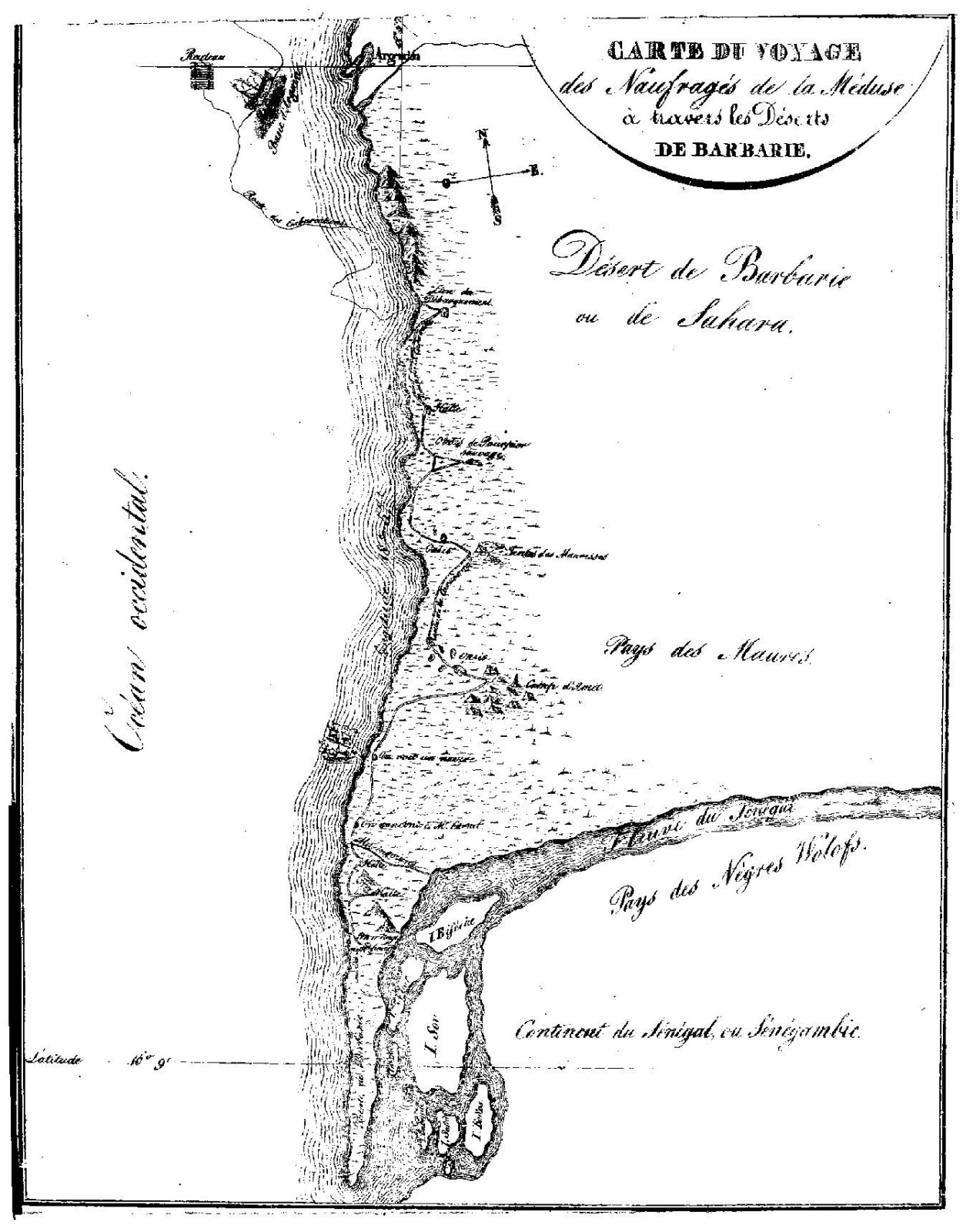 The survivors on the boats soon found themselves, by the vagaries of the winds and waves and various drama too complicated to get into, separated into two main bands. One group of 86 spent three days drifting down the coast in their lifeboats, before being forced to land and set off on foot. There they endured a miserable multi-day march across the desert, parched and starving, constantly on the verge of turning on each other. Partway through this hike, they encountered a local band of Moors, who provided much-needed aid in return for the few remaining valuables the castaways had on them. Finally, they encountered an exploring officer sent out by the British governor Brereton, who had both supplies and connections with the local tribes. After five days they reached Saint-Louis, in bad shape but alive. “It seemed,” Jonathan Miles summarizes, “that the entire colony, with the exception of [Governor] Schmaltz and Captain Chaumareys, had turned out to greet the survivors.”66
The survivors on the boats soon found themselves, by the vagaries of the winds and waves and various drama too complicated to get into, separated into two main bands. One group of 86 spent three days drifting down the coast in their lifeboats, before being forced to land and set off on foot. There they endured a miserable multi-day march across the desert, parched and starving, constantly on the verge of turning on each other. Partway through this hike, they encountered a local band of Moors, who provided much-needed aid in return for the few remaining valuables the castaways had on them. Finally, they encountered an exploring officer sent out by the British governor Brereton, who had both supplies and connections with the local tribes. After five days they reached Saint-Louis, in bad shape but alive. “It seemed,” Jonathan Miles summarizes, “that the entire colony, with the exception of [Governor] Schmaltz and Captain Chaumareys, had turned out to greet the survivors.”66
Above: Map of the journey of Medusa survivors crossing the desert, from La chaumière africaine (1824) by Charlotte-Adélaïde Dard, who took part in that walk. Public domain via Wikimedia Commons.
Another band had put ashore further north, choosing to land immediately rather than trust their lives to the ship’s overloaded and water-logged longboat. This group of 57 people thus walked four days down the coast, weak and dying, before reaching the spot where the first band had landed and begun their brutal march. They also fell in with a band of Moors, offering guns and tobacco in return for guiding them to Saint-Louis. This bargain got them desperately needed food and drink, even if the drink was — and I apologize to anyone with squeamish stomachs here — camel’s milk mixed with camel urine. Eventually this group, too, encountered British relief expeditions sent out from Saint-Louis. After 16 days wandering the desert, the band finally reached safety: “legs swollen from sunburn and insect bites… [bodies] scarred and emaciated… [and] skin broiled.”67 Five of them had died.68
You might recall I described these castaways as “somewhat-less-unfortunates.” Brace yourselves, because we’re headed back to the raft of the Medusa. I already introduced you to this raft at the start of the episode: 15 half-dead survivors being picked up by the French brig Argus. Now let’s rewind 13 days to the start of their journey, when there were 147 people on board.
The death raft
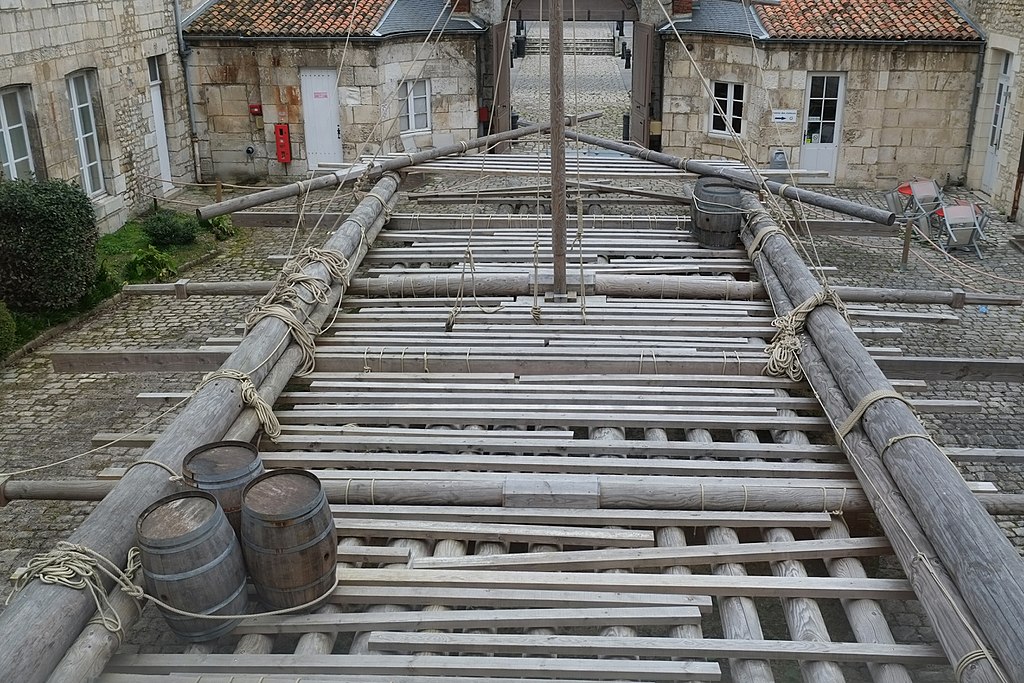
The Raft of the Medusa was in rough shape from the very beginning. It was half-submerged, with many people under water up to their waists, clinging to boards as they were battered by waves. A group of officers and leaders huddled in a slightly elevated position in the center. There were around 20 sailors, a host of civilians, and a large number of soldiers who had been dispatched to Senegal. One of the castaways was a woman and the rest were men. The survivors erected a makeshift mast and sail, which let them move, but they had no map or compass to navigate. Their first meal was waterlogged biscuits, dipped in a little wine.69
Above: Photograph of a reconstruction of the Raft of the Medusa at the Musée national de la Marine de Rochefort , by Patrick Despoix. Used under a Creative Commons Attribution-Share Alike 4.0 International license, via Wikimedia Commons.
As night fell, survivors tried to secure themselves to the raft with rope, but by daybreak a roll call found perhaps a dozen men had been washed overboard in the dark. Others threw themselves into the sea rather than endure such a doomed voyage. The sun was beating down, with little to drink and even less to eat. Survivors began to hallucinate and scream. When winds picked up, men trying to get away from the rising waves triggered a stampede that trampled several other survivors to death.70
It was on the second day that things really deteriorated. One group of soldiers broke into a cask of wine and began gorging themselves. It was these soldiers, drunk and maddened, who seem to have first began the fighting. One man grabbed an axe and tried to cut the raft apart. He was run through by an officer, but then a general melee broke out. Men were cut and stabbed, flung into the sea, or even bitten. The fighting subsided, then broke out again, as mutineers attacked and their officers counter-attacked. Before long, “the raft was strewn with dead and bludgeoned bodies.” More than half the original 147 survivors were now dead.71
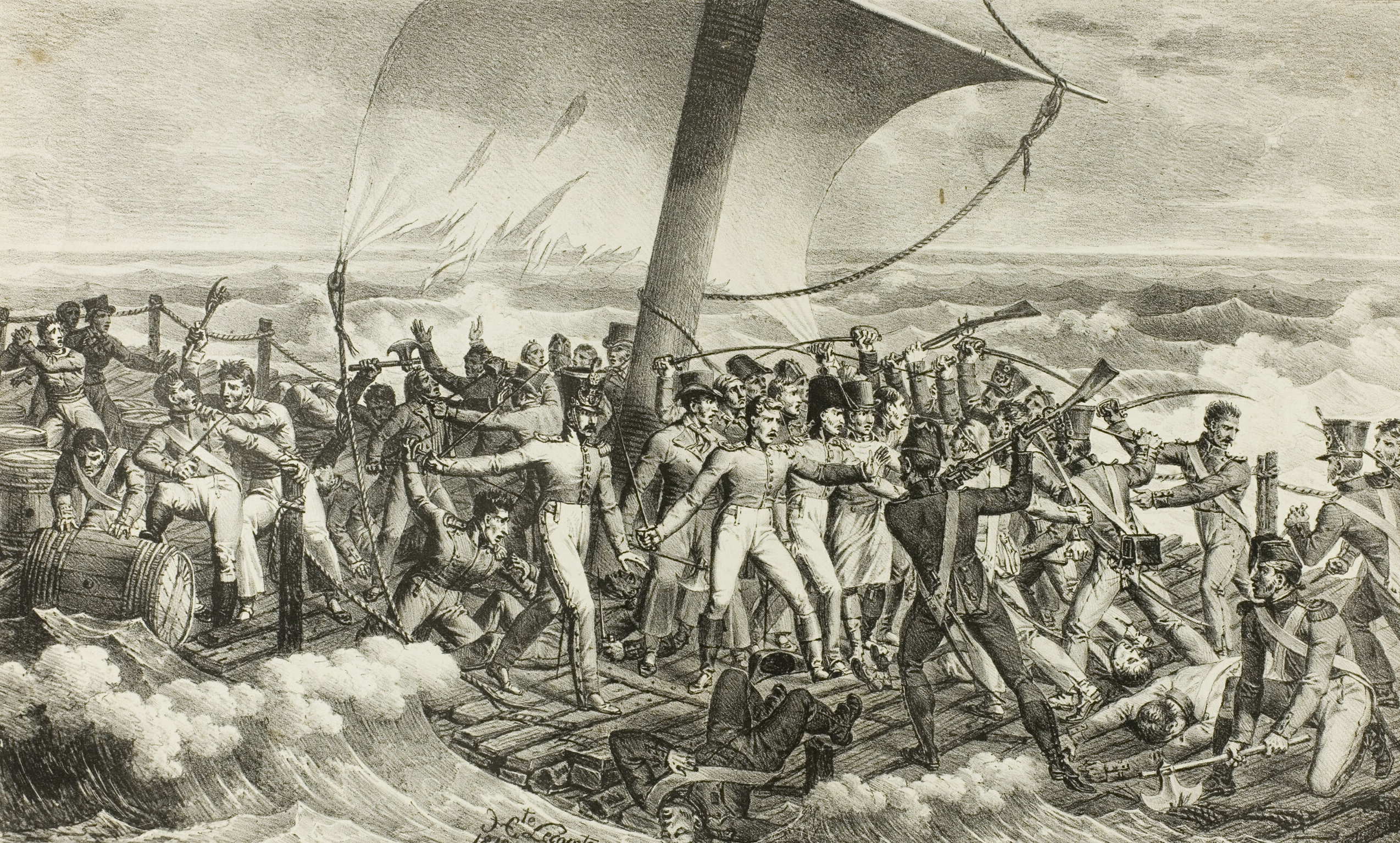
Above: Engraving of fighting between survivors on the Raft of the Medusa, by Charles Philibert de Lasteyrie after Hippolyte Lecomte, 1818. Public domain via Wikimedia Commons.
All these deaths had a single silver-lining: the raft was now much less crowded and not so waterlogged. But that was scant comfort. The survivors were wounded, starved, and thirsty. Most of their remaining supply of water and wine had been lost overboard during the fighting, leaving a single barrel of wine for drink, and essentially no food. Men tried to catch fish, but with no luck.72
It was about this point that the starving shipwreck survivors finally came to the grim realization that they actually had a lot of food on board. And as shipwreck survivors have been known to do, it didn’t take long for the hungry men to get over their qualms and begin butchering the dead bodies of their former crewmates and fellow passengers. The accounts of the men who survived this horror are perhaps understandably cagey about exactly what went on — and I’ll also spare you the details — but there is no doubt that everyone still alive on the death raft turned to cannibalism sooner or later.73
On the morning of the fifth day, after one more outbreak of fighting, there were about 30 people left on board, in increasingly desperate straits. The 12-year-old cabin boy died, and two soldiers were executed on the spot for the serious crime of drilling a hole in the sole remaining wine barrel to sneak extra drinks for themselves. There were 27 left, and now comes perhaps the moral nadir of the entire disaster: the strongest survivors, in their delirium and desperation, agreed to murder the weaker survivors in order to prolong their dwindling supply of wine. Eleven men and the lone woman were hurled into the sea to die. The published account by two of the raft’s eventual survivors pleads: “Readers who shudder at the cry of outraged humanity, recollect at least that it was other men, fellow countrymen, comrades, who had placed us in this horrible situation.”74
At this point, the frenzied madness of the first six days on the raft subsided into a slower-paced misery. The 15 remaining survivors agreed to throw their weapons into the sea, to prevent any future fighting as madness grew. Some men turned to drinking their own urine, which is apparently far from the worst source of fluids if you find yourself in such desperate straits. Spirits were raised when two vials of teeth-cleaning liquor were found, which had a pleasant taste on their parched tongues; spirits were lowered when jellyfish stung the survivors. On July 16, the men attempted to build a smaller raft to sail to shore, but it sank immediately.75
But now we are at July 17: the day the Argus’s sails were sighted on the horizon, and — eventually, rescued these 15 poor wretches, on the brink of death. Fortunately for the rescuees, the Argus’s surgeon insisted they be fed gradually, starting with small portions of broth, letting their bodies gradually adapt to normal food. Still, five of the 15 would be dead within the next few months.76
The aftermath
News reached Paris about the wreck of the Medusa on September 2, 1816, soon after Captain Vénancourt reached France with dozens of survivors on board his frigate, the Echo. Vénancourt and these survivors gave reports and wrote statements about what had happened, to inform the Naval Ministry’s inquest.77
 But September 1816 was not just any old time in France. If you recall all the way back to Episode 8, on September 5, 1816, Louis XVIII dissolved the Chambre introuvable, the ultraroyalist-dominated Chamber of Deputies whose radical policies had alarmed both foreign ambassadors and Louis’s more moderate advisors such as police minister Élie Decazes. That dissolution meant France was about to have a new round of elections — held under the same electoral rules that had produced the Chambre introuvable just the year before.
But September 1816 was not just any old time in France. If you recall all the way back to Episode 8, on September 5, 1816, Louis XVIII dissolved the Chambre introuvable, the ultraroyalist-dominated Chamber of Deputies whose radical policies had alarmed both foreign ambassadors and Louis’s more moderate advisors such as police minister Élie Decazes. That dissolution meant France was about to have a new round of elections — held under the same electoral rules that had produced the Chambre introuvable just the year before.
Right: Élie Decazes, engraved by Paolo Toschi after a painting by François Gérard, circa 1813. Public domain via Wikimedia Commons
The Medusa gave Decazes a perfect tool to change the narrative. Here was an unthinkable naval disaster, caused by the ineptitude of an ultraroyalist émigré — an exemplar of the Ultra faction Decazes was trying to defeat.
The first news of the Medusa became public on September 6, one day after the dissolution of the Chamber. Details began to slowly trickle out: on September 8 newspapers reported that survivors had been cast adrift on a makeshift raft; on September 11 came the news that most of the people on the raft had died and that the survivors had resorted to cannibalism.78
The naval ministry was doing its best to keep details as sparse as possible. “I… bemoan the fact that journalists have revealed events that should never have been placed before the eyes of mankind,” wrote the Vicomte du Bouchage, the naval minister, to the king. This attempted secrecy was not due simply to a sense of decency, but also to politics: Du Bouchage was an ultraroyalist who saw the political significance of the Medusa as well as Decazes did, both for his faction and for himself, the man who had appointed Chaumareys.79
But the elderly Du Bouchage was no match for Élie Decazes. A friendly courtier slipped Decazes a copy of a narrative of the shipwreck written by the Medusa’s surgeon, a survivor of the raft. Decazes turned around and leaked it to the Journal des débats newspaper, which devoted more than half of its September 13 issue to printing it. The salacious details immediately provoked a media frenzy, so captivating even the Ultra newspapers joined in.80 When France’s wealthy voters convened in their electoral colleges in late September and early October, they largely rejected Ultras in favor of the moderate royalists Decazes wanted. How much of this political shift was due to the news of the Medusa is impossible to say — many other things had changed from 1815 — but the horrifying stories certainly seem to have contributed.
Justice
 Captain Chaumareys arrived in France a few months later. Chaumareys seems to have had little more appreciation for the legal danger he now faced than he had for the navigational dangers he sailed into the summer prior. The captain who brought Chaumareys back home reported that he spent no time preparing a defense for the court-martial he would surely face. When he landed, Chaumareys wrote to the naval minister requesting “several months’ holiday in order to restore my health.” “By way of reply,” Miles writes, “he was arrested.”81
Captain Chaumareys arrived in France a few months later. Chaumareys seems to have had little more appreciation for the legal danger he now faced than he had for the navigational dangers he sailed into the summer prior. The captain who brought Chaumareys back home reported that he spent no time preparing a defense for the court-martial he would surely face. When he landed, Chaumareys wrote to the naval minister requesting “several months’ holiday in order to restore my health.” “By way of reply,” Miles writes, “he was arrested.”81
But while the incompetent captain’s naval career was over, his final punishment struck many as shockingly lenient. For wrecking and then abandoning his ship, Chaumareys could have faced the death penalty. Instead, the prosecutor asked only for five years in prison; the judges sentenced him to three. Du Bouchage put things frankly in a letter to Louis: “Although Chaumareys is guilty of grave error whose results have been deadly, he has, in other circumstances, given proof of courage and devotion to the Royal cause.” The same political biases that had gotten Chaumareys command of the Medusa would save his life for wrecking it.82
Above: François Joseph de Gratet, vicomte du Bouchage, French naval minister 1815-17, by an unknown artist. Public domain via Wikimedia Commons.
Chaumareys served his time, before being eventually released and retired to his family home to live out his life as a recluse and pariah; if he left his gardens local peasants would boo him and pelt him with stones.83
The painting
 There’s one final angle to the story of the Wreck of the Medusa. It may be the only reason some of you knew anything about the Medusa’s story in the first place. Because among the many French men and women who were enthralled by the story of the shipwreck and the horrifying raft was a talented young painter named Théodore Géricault.
There’s one final angle to the story of the Wreck of the Medusa. It may be the only reason some of you knew anything about the Medusa’s story in the first place. Because among the many French men and women who were enthralled by the story of the shipwreck and the horrifying raft was a talented young painter named Théodore Géricault.
Right: Portrait of Théodore Géricault by Horace Vernet, circa 1822-3. Public domain via Wikimedia Commons.
Géricault had already achieved fame in 1812 with The Charging Cuirasseur when he was just 21 years old. His career since then had been up-and-down, shaped by a turbulent inner life that included an affair with his uncle’s wife.84 But he became captivated by the story of the Medusa, and determined to capture it in paint. Géricault threw himself into the work, shaving off his hair, withdrawing from society, and spending hours studying dead bodies at the morgue and a nearby hospital operating room.85
The result debuted in the 1819 Salon, the grand exhibition that was the center of the French art world. Salon-goers saw the painting titled The Scene of the Shipwreck, a compromise title intended to obscure its actual content.86 But we today know it as The Raft of the Medusa, one of the most famous and iconic paintings in the Louvre’s collection.
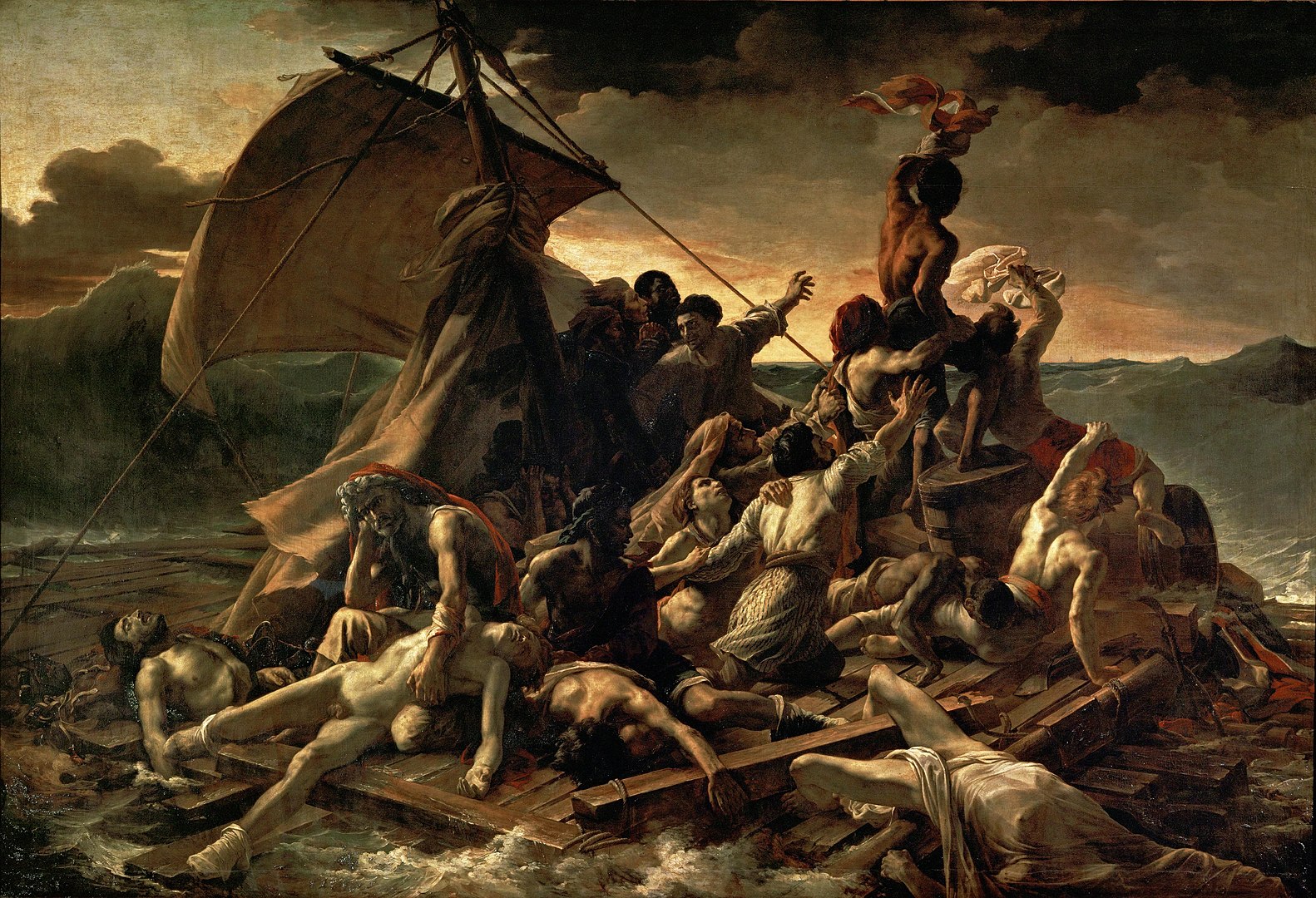
Above: Théodore Géricault’s The Raft of the Medusa, 1819. Public domain via Wikimedia Commons.
In it, Géricault depicts the moment with which I began the episode: the false hope when the survivors on the raft sight the sail of the Argus on the horizon. Surrounded by dead bodies, the survivors surge upward, waving in desperation. In its un-flinching depiction of death and misery, and in its unconventional, dynamic composition, the painting was a break from the dominant neo-classical tradition, and in line with the new Romanticism movement. I talked about the clash between Romanticism and Classicism in more detail in Supplemental 15, using the example of Eugène Délacroix’s 1824 painting, Massacre at Chios. As you might expect from that discussion, The Raft of the Medusa was controversial and drew predominantly critical reviews at the 1819 Salon. But one important figure declined to join in the criticism: Louis XVIII, who spent two hours touring the Salon in a wheelchair. The king “spent considerable time” studying Géricault’s painting, and then rendered his verdict to the nervously waiting artist. “Monsieur, you have made a shipwreck… but it is not one for you.”87
With that, I’m going to bring this discussion of the Medusa and French colonialism to a close. As always, remember you can visit thesiecle.com/episode36 to view an annotated transcript of this episode, including images such as Géricault’s The Raft of the Medusa.
Thank you for bearing with me through a long and often unpleasant episode. I hope you’ve found it as thought-provoking as I did. If you want to learn more about the Medusa, I recommend two books in particular that provided invaluable assistance writing the narrative of the shipwreck: Alexander McKee’s Wreck of the Medusa: The Tragic Story of the Death Raft, and Jonathan Miles’s The Wreck of the Medusa. The first-hand survivor narrative I quoted several times is also available in English translation, both online and in print. To find it, look up Narrative of a Voyage to Senegal by Jean-Baptiste Henry Savigny and Alexander Corréard.
My thanks also to several people who helped make this episode possible. That includes Robin Beasley, who edited this episode, and Thierry Coulibaly, for pronunciation assistance. Thanks also to the show’s supporters on Patreon, without whom The Siècle couldn’t exist. Since last episode, they’ve been joined by Elliott Snyder and Nicholas Grabstas. All patrons of whatever tier receive an ad-free feed of the show.
Now, as is usual for me, I’m going to hit “publish” and immediately get to work on the next episode of the show. When that drops very soon you’ll hopefully see why I picked now to explore France’s colonial empire, because we’re going to venture across the Mediterranean Sea from France to look at the history of a city that’s about to become extremely important for the show’s narrative. Join me next time for Episode 37: Algiers.
-
Jonathan Miles, The Wreck of the Medusa (New York: Grove Press, 2007), 108-10. ↩
-
J-B. Henry Savigny and Alexandre Corréard, Narrative of a Voyage to Senegal, translator unknown (London: 1818, and Marlboro, Vermont: The Marlboro Press, 1986), 61, 68. Miles, The Wreck of the Medusa, 56-59. ↩
-
Miles, The Wreck of the Medusa 111. ↩
-
“France: Africa: French West Africa and the Sahara”, Statesman’s Year-Book (London: Macmillan and Co., 1921), 895. ↩
-
Robert Aldrich, Greater France : A History of French Overseas Expansion (New York: St. Martin’s Press, 1996), 15, 20. Miles, The Wreck of the Medusa, 114-5. ↩
-
Boubacar Barry, Senegambia and the Atlantic Slave Trade (Cambridge: Cambridge University Press, 1998), 138, 181, xxii-xxiii. ↩
-
Barry, Senegambia, 69-73. James L. A. Webb Jr., “The Trade in Gum Arabic: Prelude to French Conquest in Senegal,” The Journal of African History 26, no. 2 (1985), 149–52. Edward Copeland, “Money,” in The Cambridge Companion to Jane Austen, ed. Edward Copeland and Juliet McMaster (Cambridge: Cambridge University Press, 1997), 135. ↩
-
Barry, Senegambia, 62-8. The lower estimates come from earlier scholars, while more recent work has pointed to a higher figure. ↩
-
Barry, Senegambia, 107-12. ↩
-
Hilary Jones, The Métis of Senegal (Bloomington and Indianapolis: Indiana University Press, 2013), 19-22. Barry, Senegambia, 74-93. ↩
-
Webb, “The Trade in Gum Arabic,” 152. Jones, The Métis of Senegal, 33. Miles, The Wreck of the Medusa, 214. ↩
-
Adam Zamoyski, Rites of Peace: The Fall of Napoleon and the Congress of Vienna (London: Harper Perennial, 2007), 198. ↩
-
Zamoyski, Rites of Peace, 200-1. ↩
-
Peter Dixon, George Canning: Politician and Statesman (New York: Mason/Charter, 1976), 220. ↩
-
Dixon, George Canning, 219-23. Miles, The Wreck of the Medusa, 214-5. ↩
-
Miles, The Wreck of the Medusa, 215. ↩
-
Miles, The Wreck of the Medusa, 218. ↩
-
Guillaume de Bertier de Sauvigny, The Bourbon Restoration, translated by Lynn M. Case (Philadelphia: The University of Pennsylvania Press, 1966), 75. ↩
-
Alexander McKee, Wreck of the Medusa (New York: Signet, 1975), 7. Miles, The Wreck of the Medusa, 24-6. In fact Chaumareys had been initially appointed in 1815 to command a single ship in the expedition to Senegal, but this expedition was cancelled by Napoleon’s escape from Elba. When the expedition got going again in 1816, Chaumareys was in overall command. ↩
-
McKee, Wreck of the Medusa 7-10. Miles, The Wreck of the Medusa, 24-28. ↩
-
Miles, The Wreck of the Medusa, 39. ↩
-
McKee, Wreck of the Medusa 16-7. Miles, The Wreck of the Medusa, 38-9. ↩
-
McKee, Wreck of the Medusa, 24, 26-7. ↩
-
Miles, The Wreck of the Medusa, 43-4. ↩
-
Miles, The Wreck of the Medusa, 44-5, 148. ↩
-
Miles, The Wreck of the Medusa, 45. ↩
-
McKee, Wreck of the Medusa, 34-6. ↩
-
McKee, Wreck of the Medusa, 37. ↩
-
McKee, Wreck of the Medusa, 37-8. ↩
-
McKee, Wreck of the Medusa, 37. ↩
-
In fact, the Medusa had run aground at high tide, and in fact at the peak high tide — each subsequent high tide for the next week would be slightly lower. McKee, Wreck of the Medusa, 39. ↩
-
Miles, The Wreck of the Medusa, 52, McKee, Wreck of the Medusa, 43. ↩
-
McKee, Wreck of the Medusa, 39. ↩
-
Miles, The Wreck of the Medusa, 52, 54. ↩
-
Miles, The Wreck of the Medusa, 54-5. ↩
-
Miles, The Wreck of the Medusa, 55. ↩
-
Miles, The Wreck of the Medusa, 56-7. McKee, Wreck of the Medusa, bookplate. ↩
-
Miles, The Wreck of the Medusa, 57-61. ↩
-
Miles, The Wreck of the Medusa, 59, 94. ↩
-
Miles, The Wreck of the Medusa, 60. ↩
-
Miles, The Wreck of the Medusa, 61-2. ↩
-
McKee, Wreck of the Medusa, 50-66, bookplate. ↩
-
Miles, The Wreck of the Medusa, 113-5. The two boats were in fact picked up by the Echo a day out of Saint-Louis and finished their voyage on board. ↩
-
Miles, The Wreck of the Medusa, 115. ↩
-
McKee, Wreck of the Medusa, 149-50. ↩
-
Zamoyski, Rites of Peace, 198. Siba Pada Sen, The French in India, 1763-1816 (Calcutta: Kirma K.L. Mukhopadhyay, 1958), 598-601. ↩
-
Sen, The French in India, 599-600. ↩
-
Miles, The Wreck of the Medusa, 218. ↩
-
Miles, The Wreck of the Medusa, 218-9. Dixon, George Canning, 221. ↩
-
Miles, The Wreck of the Medusa, 219-20. ↩
-
De Sauvigny, The Bourbon Restoration, 180. ↩
-
Dixon, George Canning, 221-3. Miles, The Wreck of the Medusa, 221. ↩
-
Jones, The Métis of Senegal, 48-50. ↩
-
Barry, Senegambia, 138-9. ↩
-
Mary Dewhurst Lewis, “Legacies of French Slave-Ownership, or the Long Decolonization of Saint-Domingue,” History Workshop Journal, no. 83 (2017), 152-3. ↩
-
Marlene Daut, “When France extorted Haiti — the greatest heist in history,” The Conversation, June 30, 2020. Lewis, “Legacies of French Slave-Ownership,” 159. The Louisiana Purchase had been at an exchange rate of $15 million equal to 80 million francs. “Louisiana Purchase Treaty (1803),” National Archives. ↩
-
Lewis, “Legacies of French Slave-Ownership,” 153. ↩
-
Lewis, “Legacies of French Slave-Ownership,” 153. ↩
-
Daut, “When France extorted Haiti.” Different sources cite different dates for when Haiti finally paid off this debt, with Daut citing 1947. Historian Alexandra Yates cites historian François Blancpain’s 2001 book, Un siècle de relations financières entre Haïti et la France, 1825-1922, who draws on primary sources to identify 1883 as the end date. But the issue is complicated, since Haiti took out multiple foreign loans over the years, and disentangling these subsequent loans from the original debt can be tricky. Alexia Yates, personal correspondence. ↩
-
Daut, “When France extorted Haiti.” ↩
-
Lewis, “Legacies of French Slave-Ownership,” 155-6. ↩
-
Lewis, “Legacies of French Slave-Ownership,” 155. ↩
-
Alexia Yates, “Defending the Haitian Debt: Bondholder Activism in 19th-century France,” The University of Manchester, Jan. 17, 2021. Alexia Yates, “Making Investor States: Haitian Foreign Debt and Neo-colonial Economic Governance in Nineteenth-century France,” in Imperial Inequalities: The Politics of Economic Governance across European Empires, ed. Gurminder Bhambra and Julia McClure (Manchester: Manchester University Press, 2022), 4-20. ↩
-
Miles, The Wreck of the Medusa, 122. ↩
-
Miles, The Wreck of the Medusa, 122-3. ↩
-
Miles, The Wreck of the Medusa, 66-86. ↩
-
Miles, The Wreck of the Medusa, 87-93. ↩
-
McKee, Wreck of the Medusa, 146. There are some disagreements between Miles and McKee as to the exact size of each land expedition. ↩
-
Miles, The Wreck of the Medusa, 94-7. ↩
-
Miles, The Wreck of the Medusa, 98. ↩
-
Miles, The Wreck of the Medusa, 98-102. McKee, Wreck of the Medusa 88-102. ↩
-
McKee, Wreck of the Medusa, 103-4. ↩
-
Miles, The Wreck of the Medusa, 103-5. ↩
-
Miles, The Wreck of the Medusa, 106-8. Savigny and Corréard, Narrative of a Voyage to Senegal, 59. ↩
-
Miles, The Wreck of the Medusa, 108-110. ↩
-
Miles, The Wreck of the Medusa, 111-2. ↩
-
Miles, The Wreck of the Medusa, 124-5. ↩
-
Miles, The Wreck of the Medusa, 135-6. ↩
-
McKee, Wreck of the Medusa, 178. Miles, The Wreck of the Medusa, 21. ↩
-
Miles, The Wreck of the Medusa, 136-8. ↩
-
Miles, The Wreck of the Medusa, 145. ↩
-
McKee, Wreck of the Medusa 185, 193-200. Miles, The Wreck of the Medusa, 150-1. ↩
-
Miles, The Wreck of the Medusa, 231. ↩
-
Miles, The Wreck of the Medusa, 19, 159-63. ↩
-
Miles, The Wreck of the Medusa, 167-72. ↩
-
Miles, The Wreck of the Medusa, 182. ↩
-
Miles, The Wreck of the Medusa, 182-6. ↩
